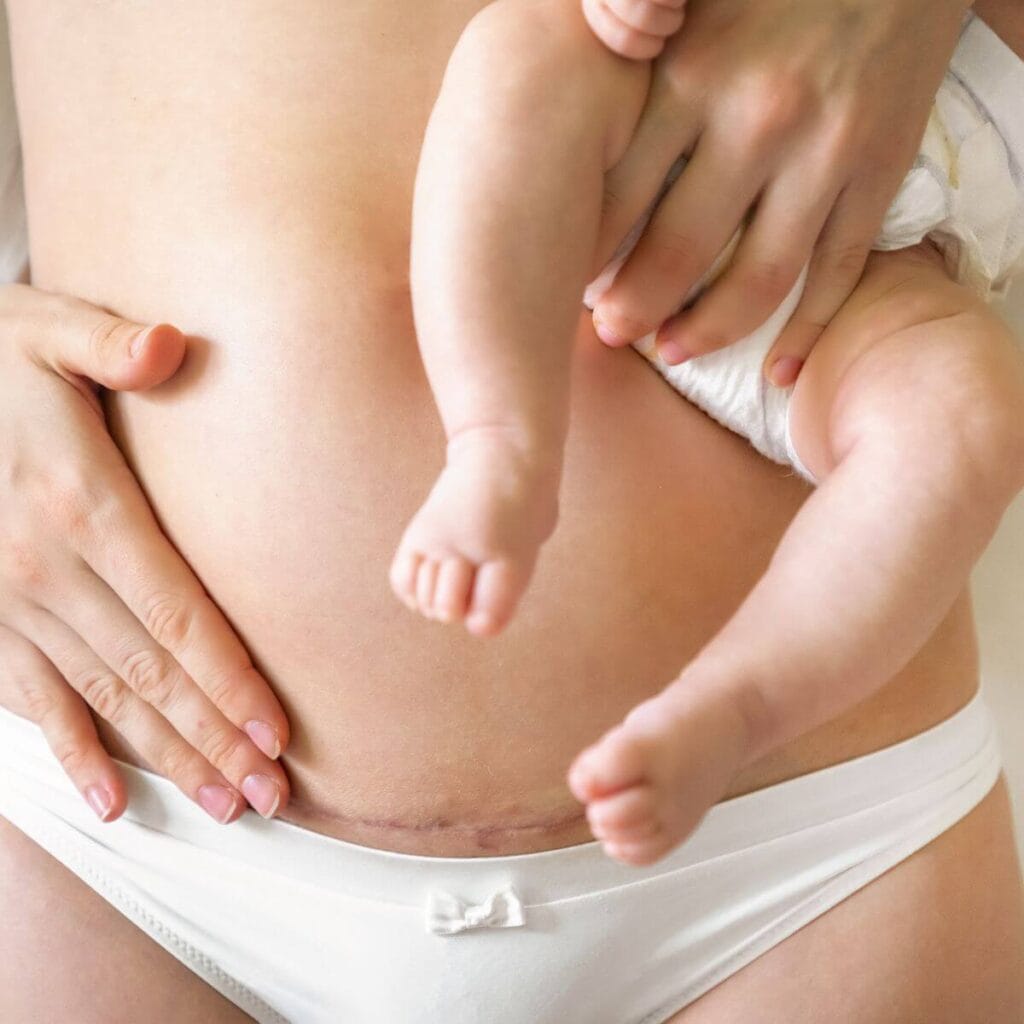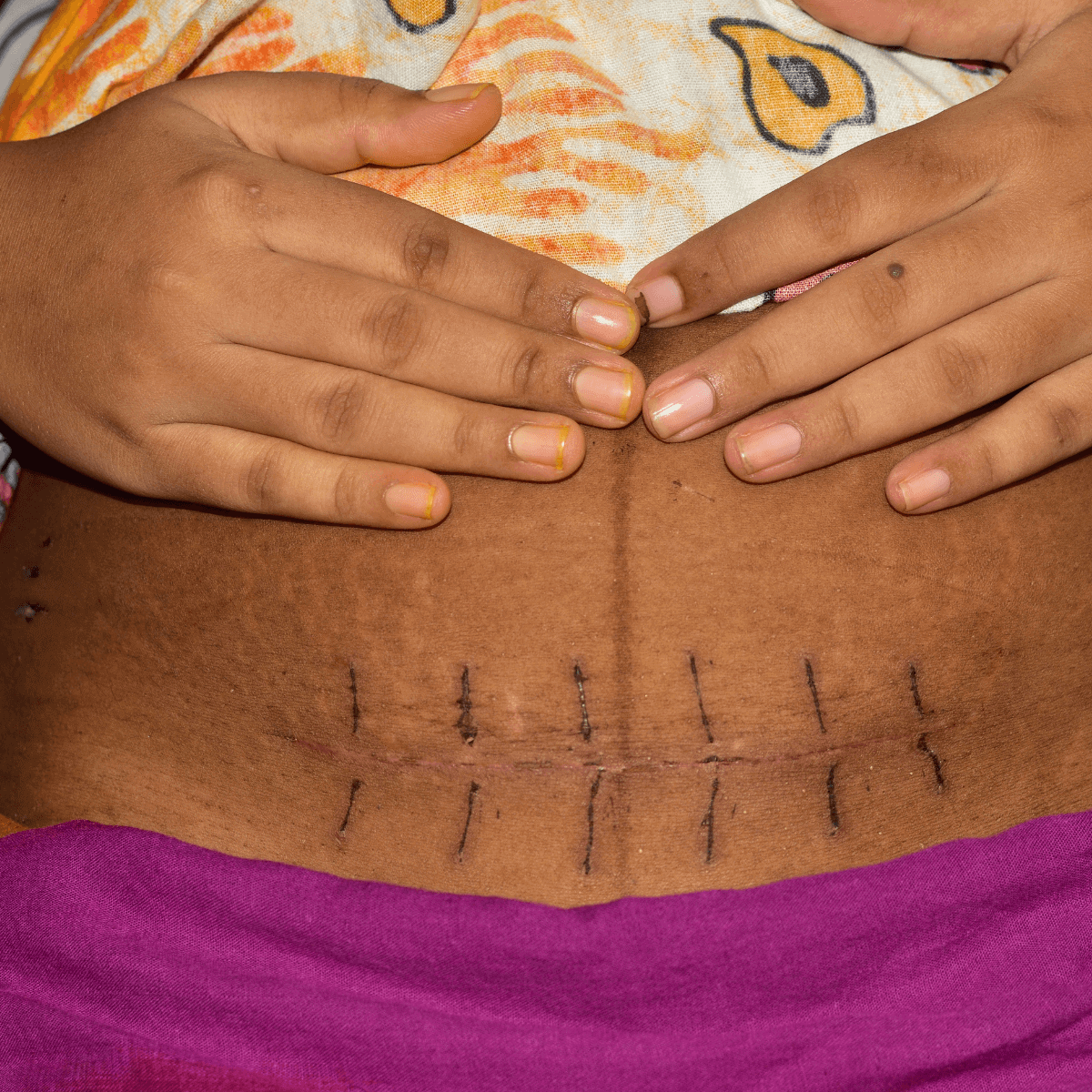When we embark on the journey of motherhood, we imagine the joy of holding our baby for the first time, the precious moments of bonding, and the adventures that await. What we often don’t anticipate, however, are the unexpected twists and turns along the way.
For some, like me, this journey involves a C-section and the subsequent scar that remains as a testament to the life we brought into the world. While this scar might seem like a small detail in the grand scheme of things, it’s a crucial aspect of the postpartum recovery process. Caring for it properly can make a world of difference to your overall well-being.
I remember the moment I realized I was headed for a C-section with my first baby. I thought I was prepared for postpartum, but labor hadn’t gone anywhere near how I was expecting (hello 10 lb baby!), and I quickly realized I didn’t have any knowledge about how to heal from a C-section or C-section specific recovery items.
It became increasingly clear that the challenges of recovering from a C-section were different from what I’d initially prepared for. One area I felt particularly uneducated about was caring for that significant scar.
Fast forward 8 months later, armed with insights from my pelvic floor therapist, advice from fellow moms, and, of course, many late-night Google searches, and I feel a lot more educated and equipped.
This post is not just my journey, but a guide for all mothers out there navigating the complexities of C-section scar care. I believe that by sharing our experiences, we can make the path a tad bit smoother for others.

This site contains affiliate links, meaning that we earn a small commission for purchases made through our site. We only recommend products we personally use, love, or have thoroughly vetted.
The Healing Process: Patience is Key
One of the first things to understand about a C-section scar is that it’s not just a surface wound. Beneath that linear mark is a story of layers of tissue that have been carefully stitched back together (btw, this is why it’s so important to eat foods that help you heal after a C-section).
Recognizing the depth and intricacy of this wound is essential for managing expectations and providing the best care.
Typical Healing Timeline for C-section Scars:
- Immediate Phase (0-10 days): The scar may be red and puffy. It’s essential to keep it clean and dry while the body actively works on the healing process.
- Repair Phase (10 days – 6 weeks): Collagen starts to form, providing strength to the healing tissue. Avoid heavy activities, and remember that itchiness, while annoying, signals healing.
- Remodeling Phase (6 weeks – 1 year & beyond): Here, the scar begins to fade and soften. With proper care, it will gradually blend into your skin.
Rushing recovery isn’t beneficial. Remember, societal ‘snap-back’ expectations aren’t always realistic. Prioritize rest and cleanliness. Listen to your body, and consult your healthcare provider if something seems off.
Your scar symbolizes the resilience of motherhood. Treated with patience and care, it will heal beautifully, standing as a testament to your incredible journey.

Tips for Caring for Your C-Section Scar
Your C-section scar is a badge of honor, a reminder of the incredible journey you undertook to bring life into this world. Here are some tips to ensure your scar heals well:
1. Proper Wound Care
Keeping your scar clean and dry, especially in the early days, is paramount. This prevents infections and complications.
Avoid soaking in baths or swimming until your healthcare provider gives you the green light. If you notice any unusual discharge, swelling, or increased redness, it’s essential to seek medical advice immediately.
2. Scar Massage Techniques
Benefits: Massaging your scar can promote circulation, which aides in faster healing. It can also reduce redness and soften the scar tissue, making it less noticeable.
Additionally, consistent scar massage can improve skin elasticity and flexibility, ensuring the surrounding tissue remains supple. Scar massage also facilitates more comfortable movement as you go about your daily activities.
How to Do It: With clean hands, gently massage your scar in a circular motion. Start with light pressure, and as the scar matures, you can apply slightly more force.
Be sure to be cleared at your 6-week check-up before beginning scar massage. At the beginning, it may be best to massage around the scar rather than directly on it as it may still be tender and painful.
My pelvic floor therapist encouraged me to “play the piano” on my scar and practice moving it left and right, up and down. Although touching your scar may be the last thing you want to do (trust me, I get it) massaging the scar even a few minutes a day in the shower or before you go to bed can make a big difference long term.
3. Utilizing Silicone Strips
Benefits: Silicone strips can work wonders for C-section scars. They help to hydrate the skin, which can reduce scar visibility and prevent excessive scar tissue from forming. Additionally, these strips help in flattening raised scars.
How to Use: After ensuring the wound is fully closed, apply the silicone strip on the scar. It’s advised to wear them for at least 12 hours a day for optimal results.
4. Using Scar Healing Creams and Ointments
What to Look For: Opt for products that contain ingredients known for promoting healing, like Vitamin E, onion extract, and silicone. Avoid products with irritants or excessive fragrances. Always do a patch test before fully committing to a new product to ensure you don’t have a reaction.
Remember, while these tips can guide you in scar care, everyone’s body is different. It’s essential to consult with healthcare professionals and listen to your body’s unique needs.
The Beauty of C-Section Scars: Celebrating Motherhood
Our bodies tell stories. Every line, every curve, and every scar holds a narrative of experiences lived and challenges overcome.
Among these tales, a C-section scar stands out, not as a mark of surgical intervention, but as a profound symbol of motherhood. It’s a testament to the strength, resilience, and boundless love that defines the journey of bringing a new life into this world.
For the first few months postpartum I hated my C-section scar. I didn’t like looking at it, much less trying to care for it, but gradually my perspective shifted. I began to appreciate my scar because it brought me the greatest gift in the world: my daughter.
I encourage you to embrace your scar with pride and love. Recognize it as a badge of honor, a mark that showcases your courage, determination, and the incredible journey you undertook for the love of your child.
Your C-section scar is a permanent part of your story. Just as every child’s birth is unique, so is the journey of every mother. Instead of perceiving it as a mere remnant of surgery, try to see it as a beautiful chapter in your tale of motherhood.
Celebrate it, cherish it, and wear it with pride. It stands as an emblem of one of life’s most miraculous experiences.
Final Thoughts
Navigating the intricacies of C-section scar care was a learning curve for me, especially as a first-time mom. Remember the essentials: be patient with the healing process, integrate daily care routines like silicone strips and scar massages, and prioritize optimal healing with the right ointments.
To all readers on this recovery journey, your scar is a symbol of your immense strength and dedication as a mother. As you continue on this path, know you’re supported and celebrated. Embrace your scar, trust in your resilience, and cherish this unique mark of your motherhood journey!












